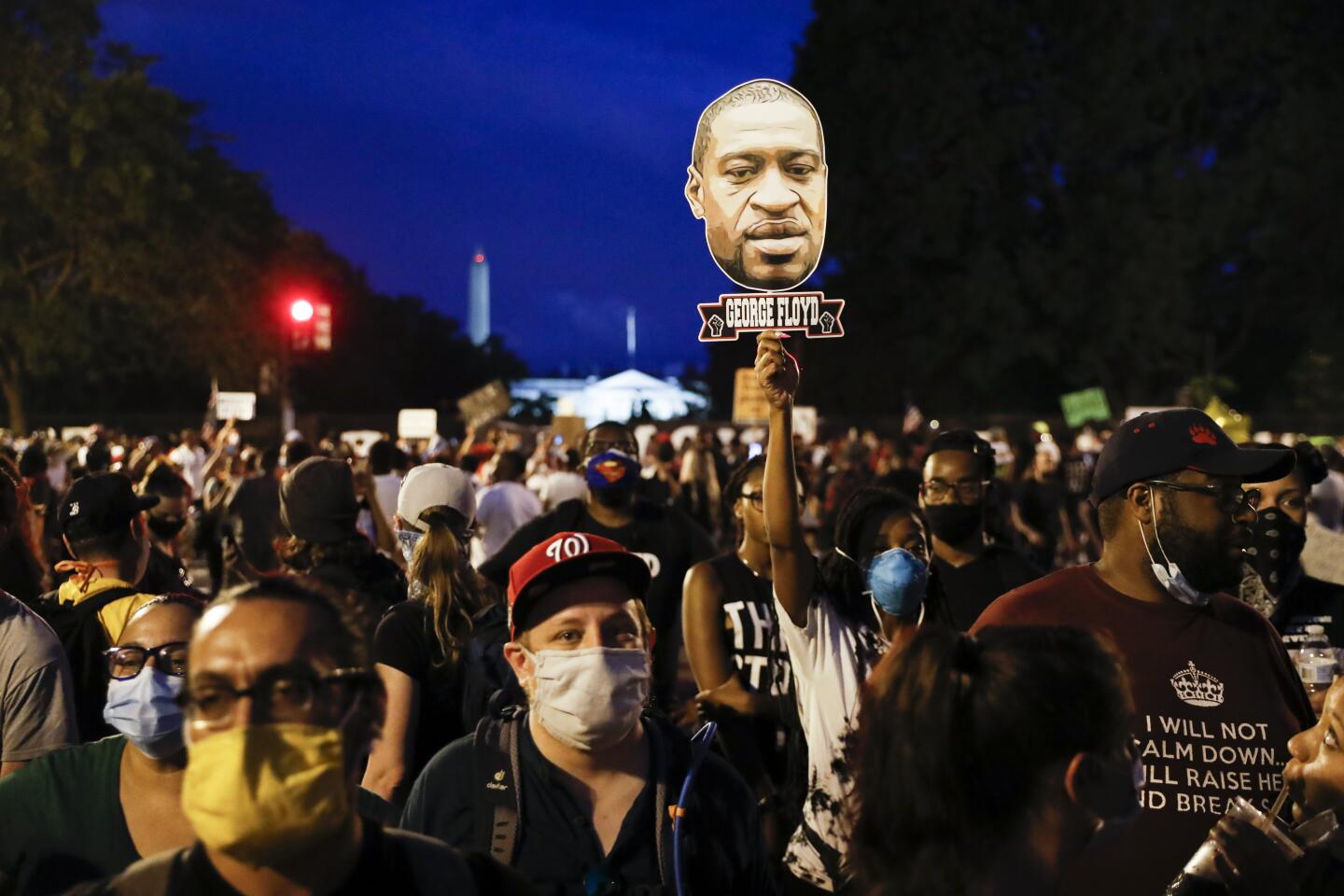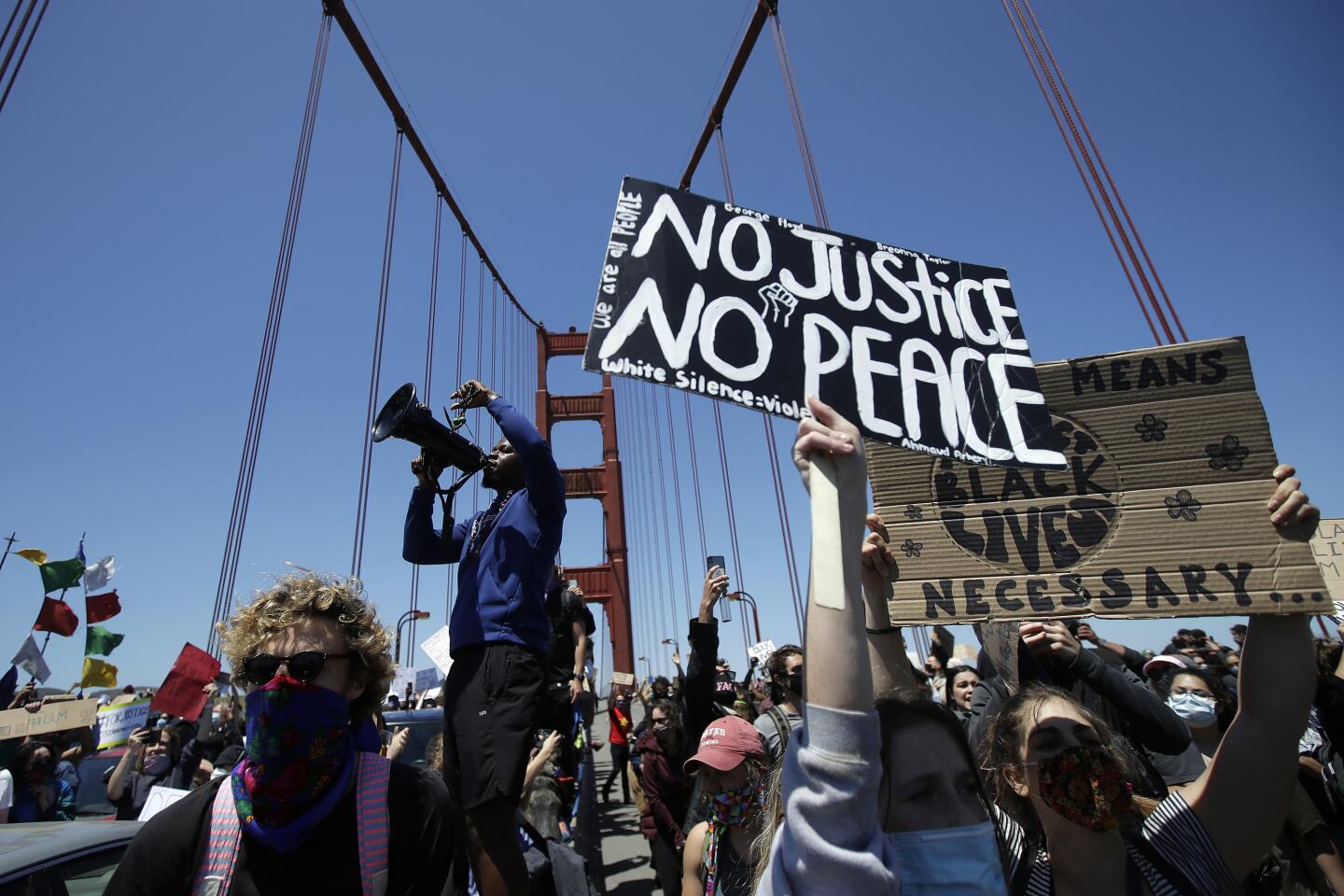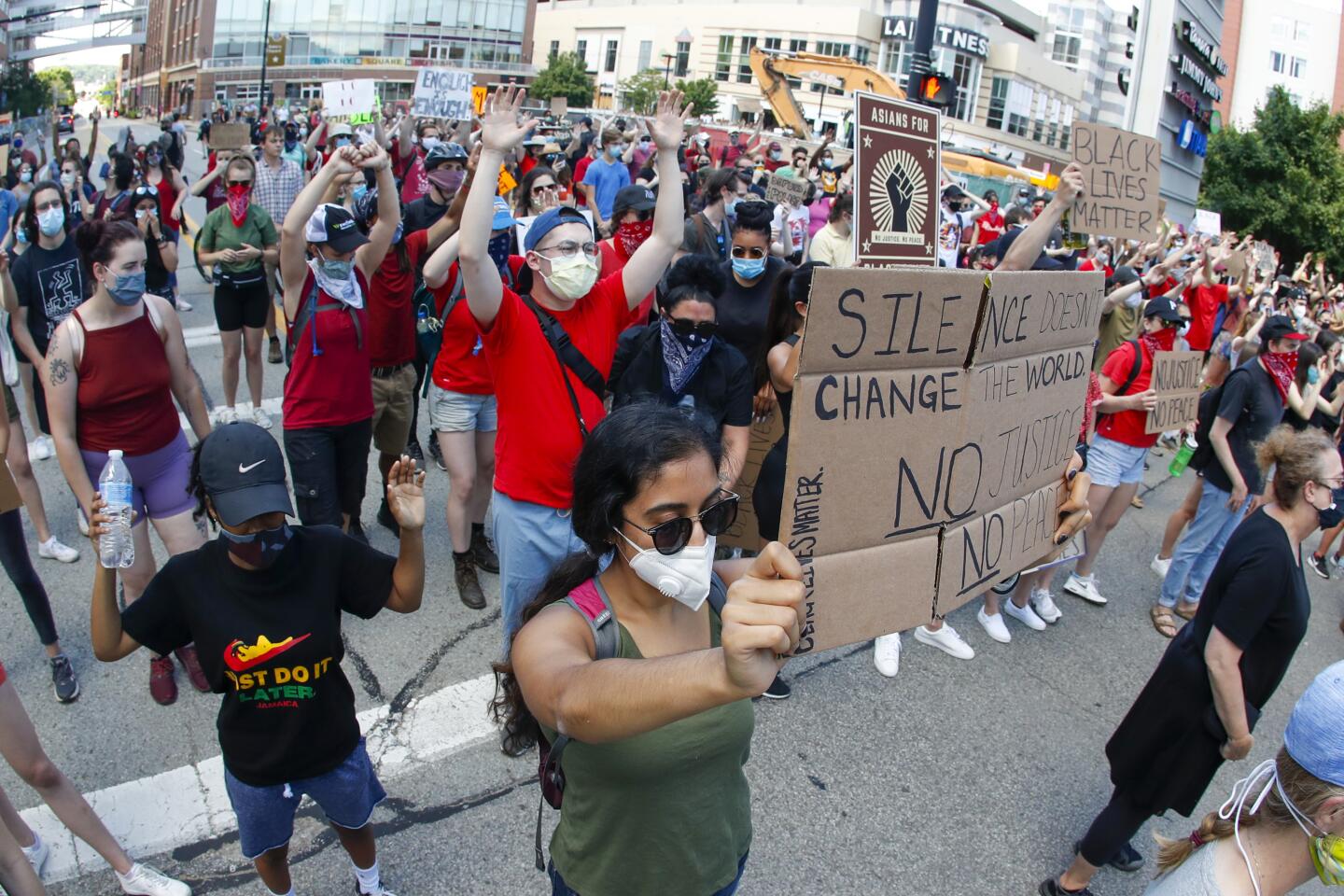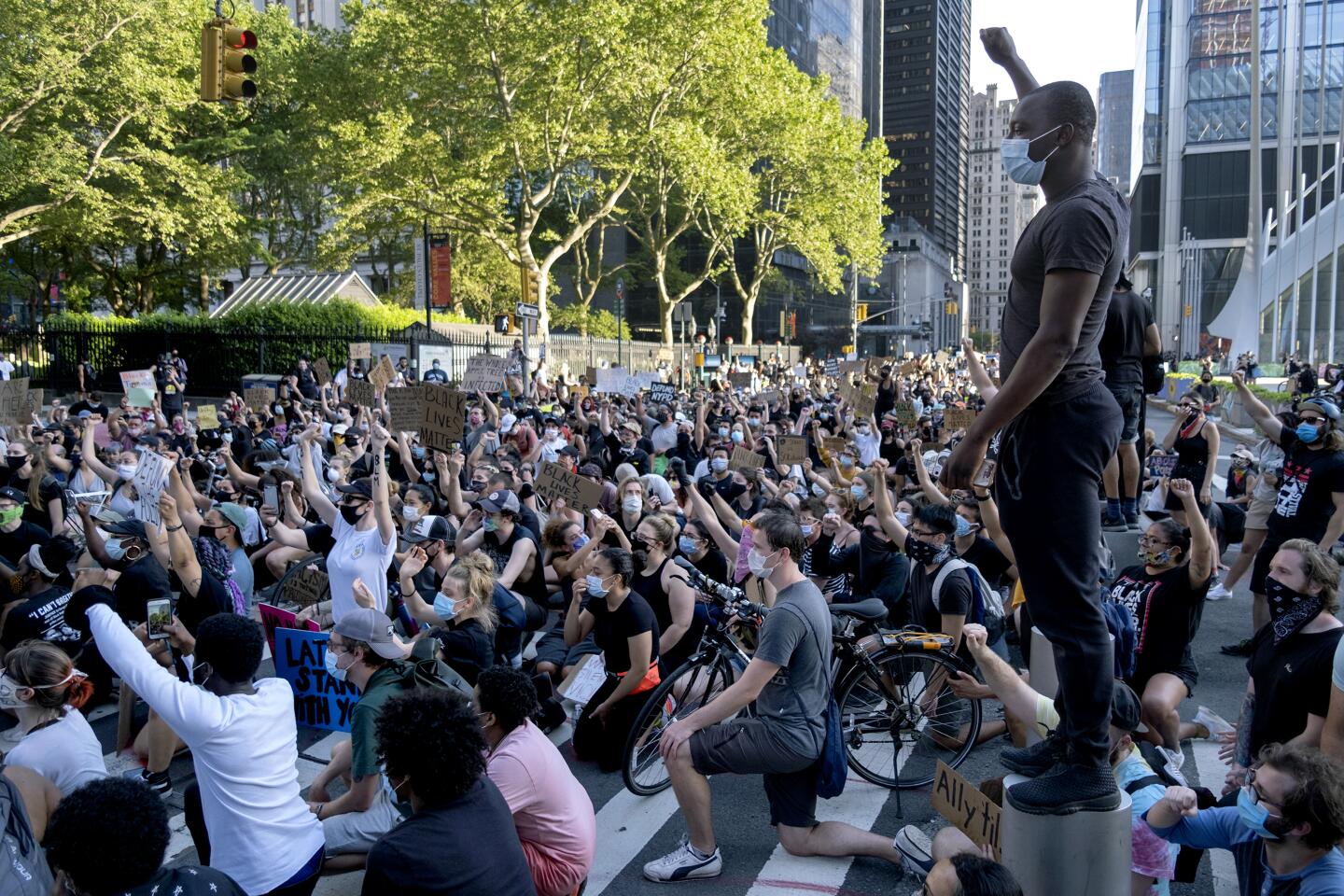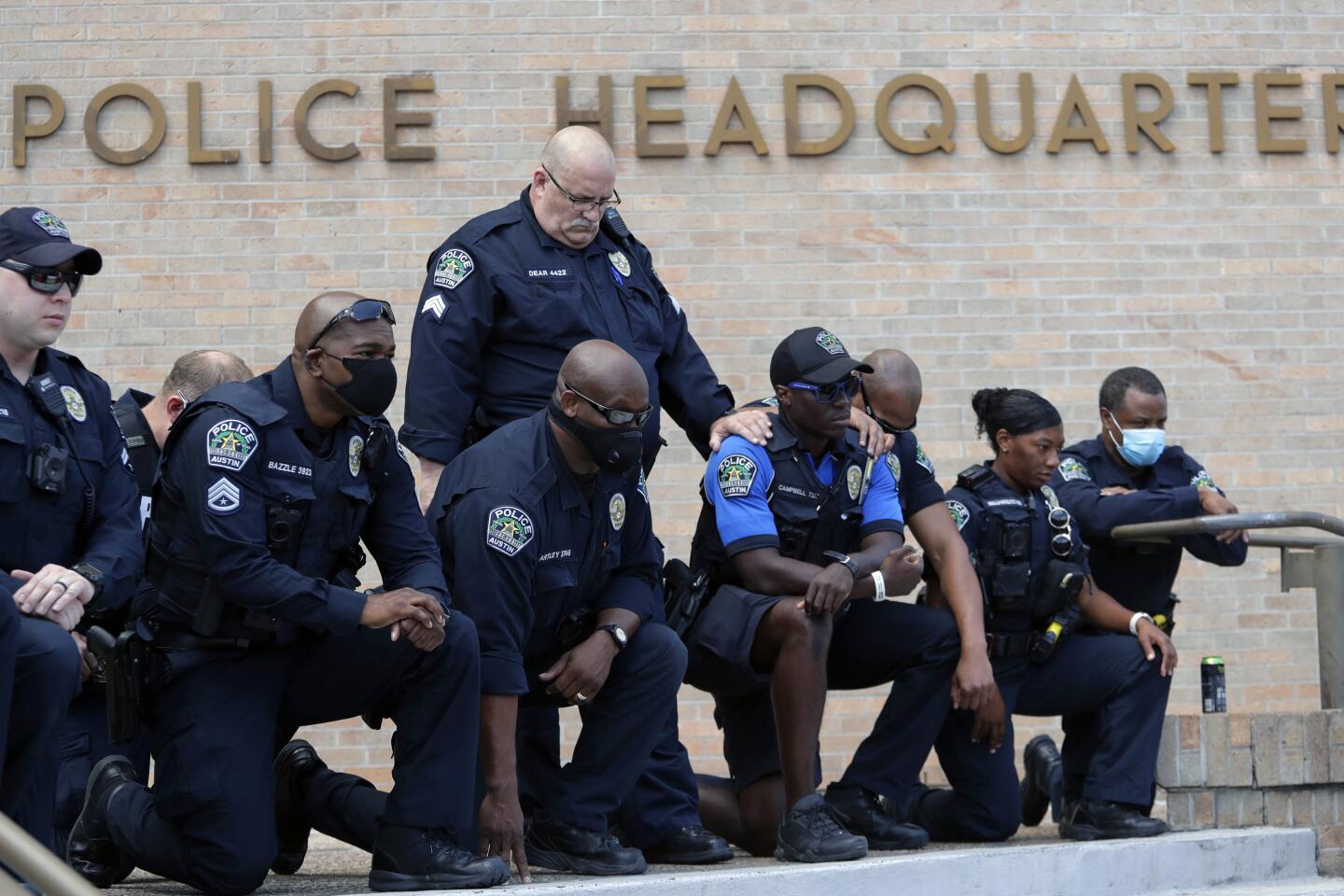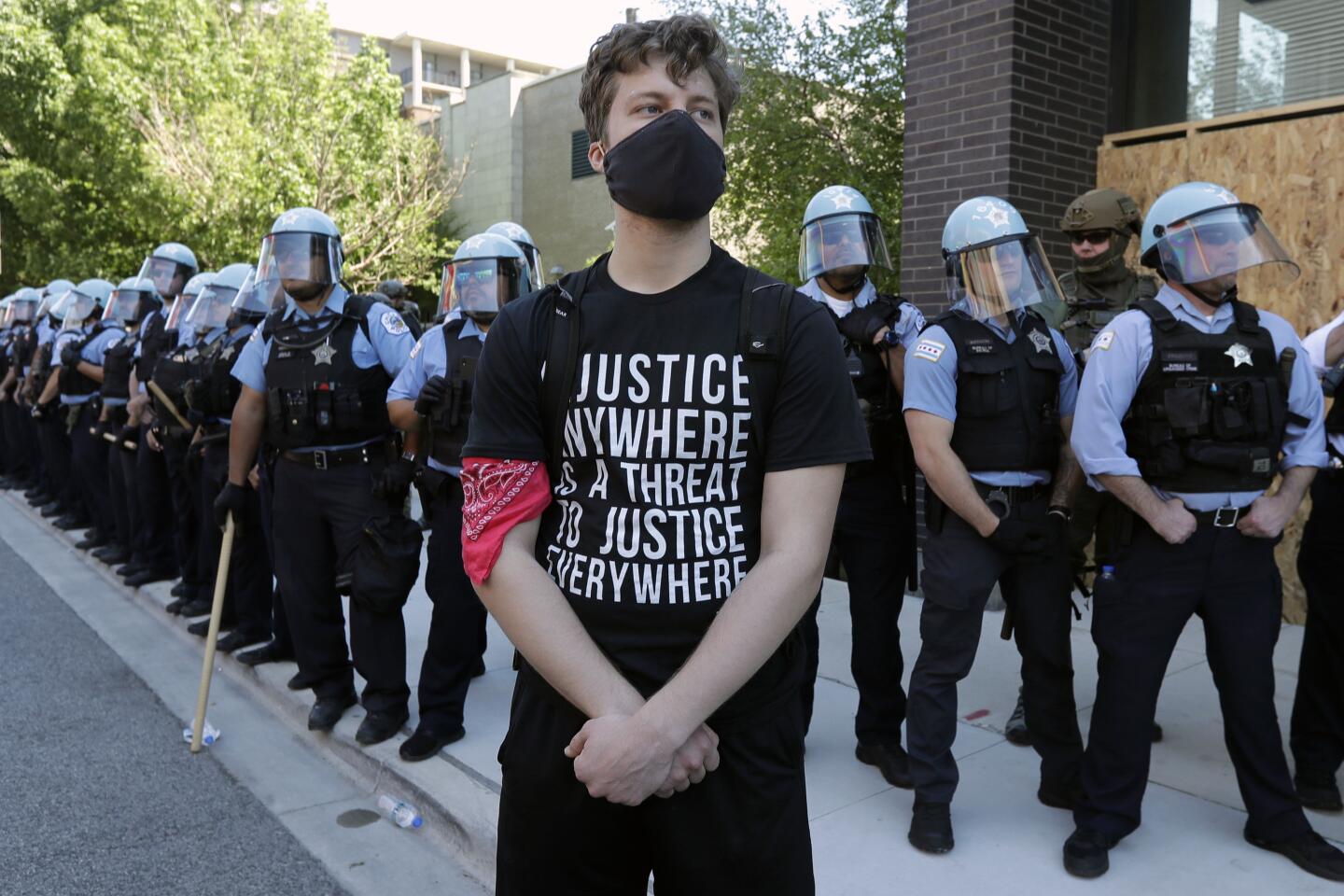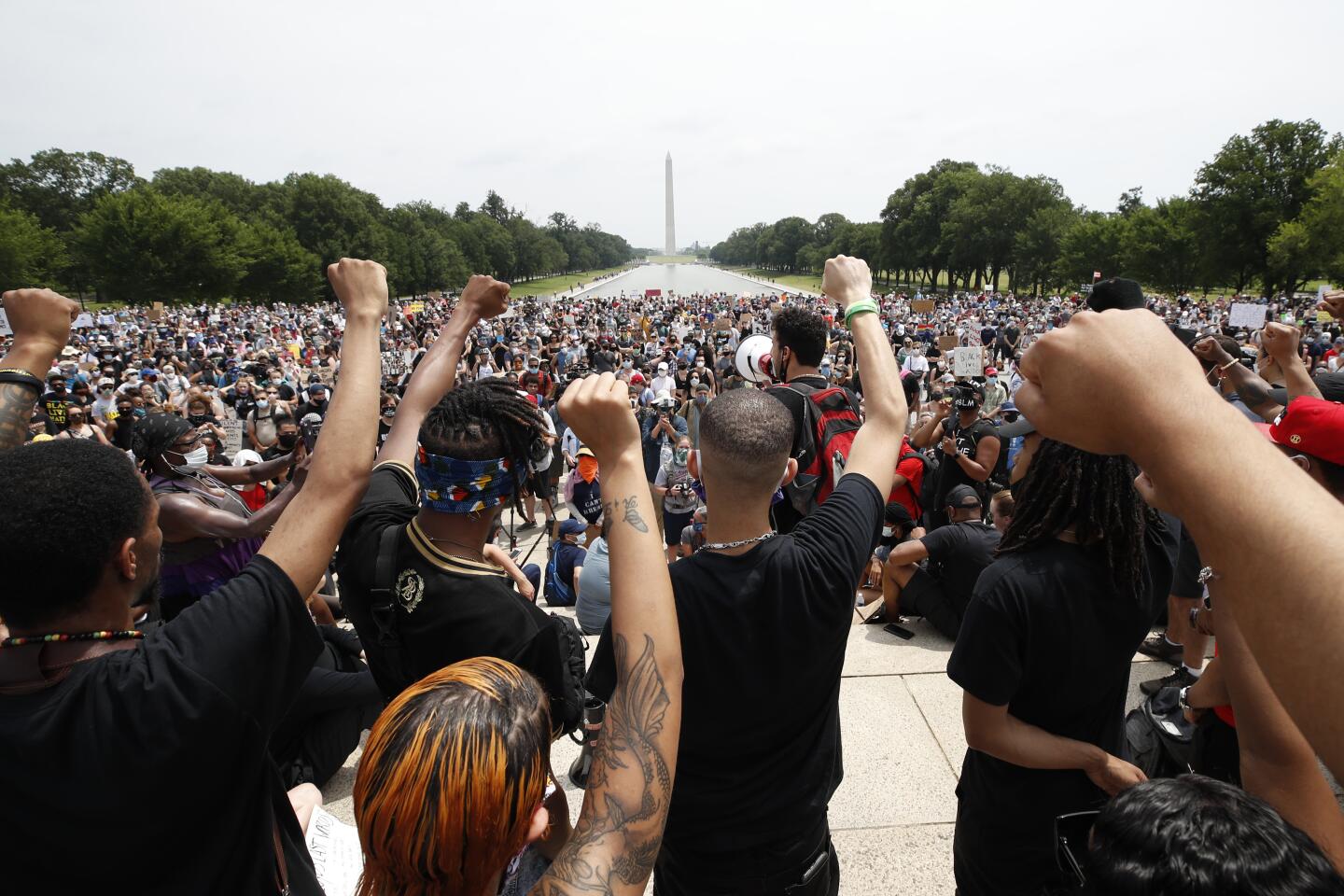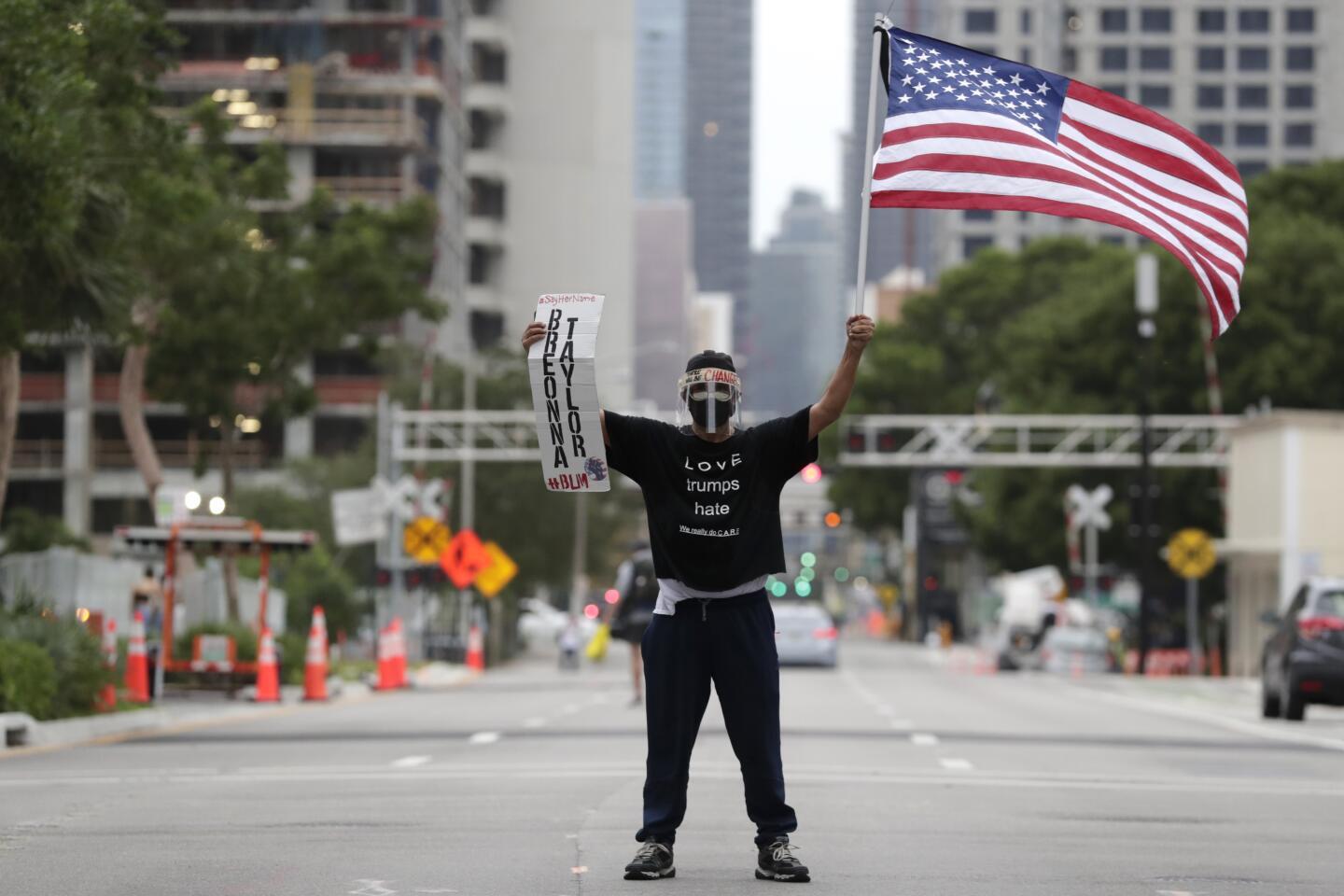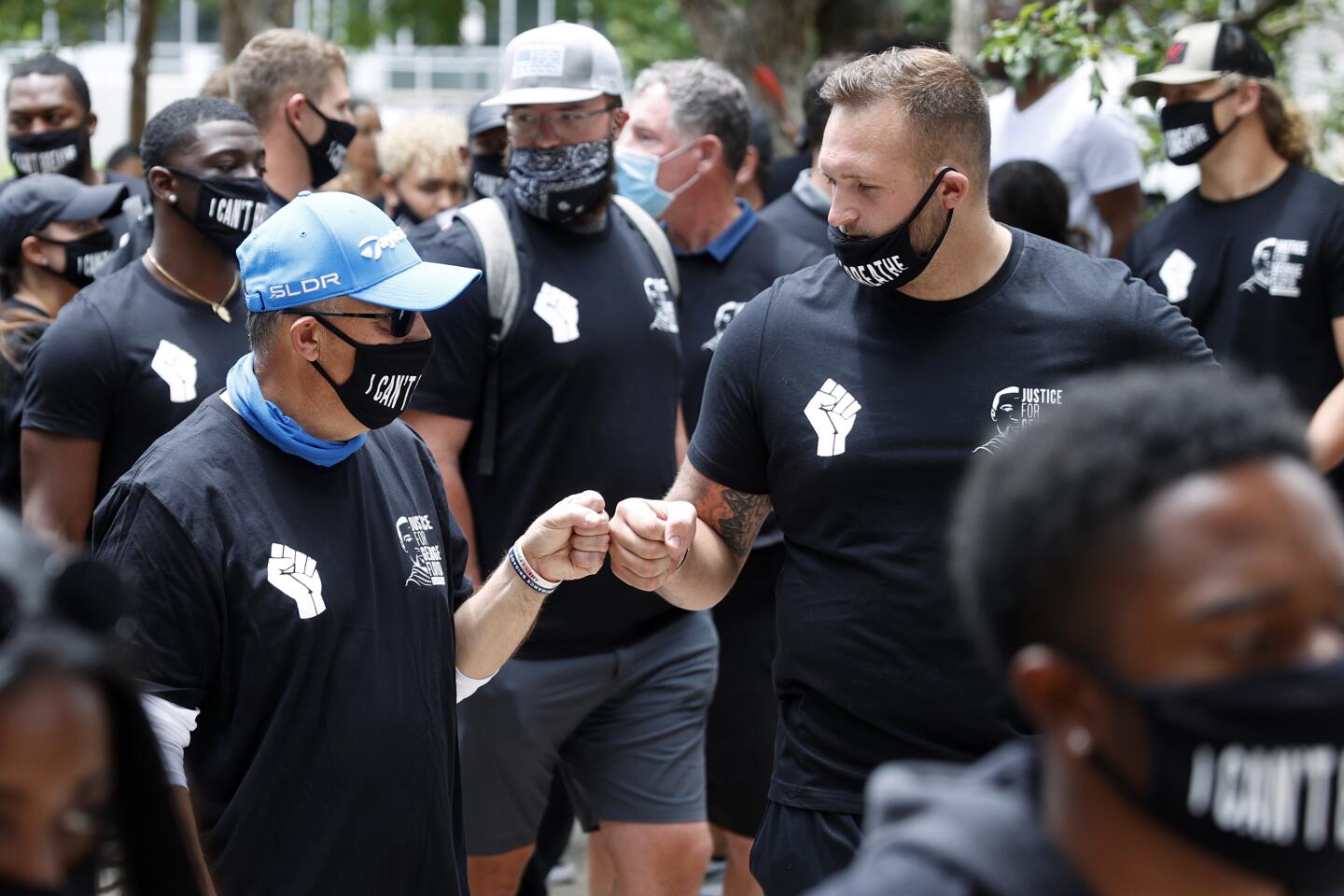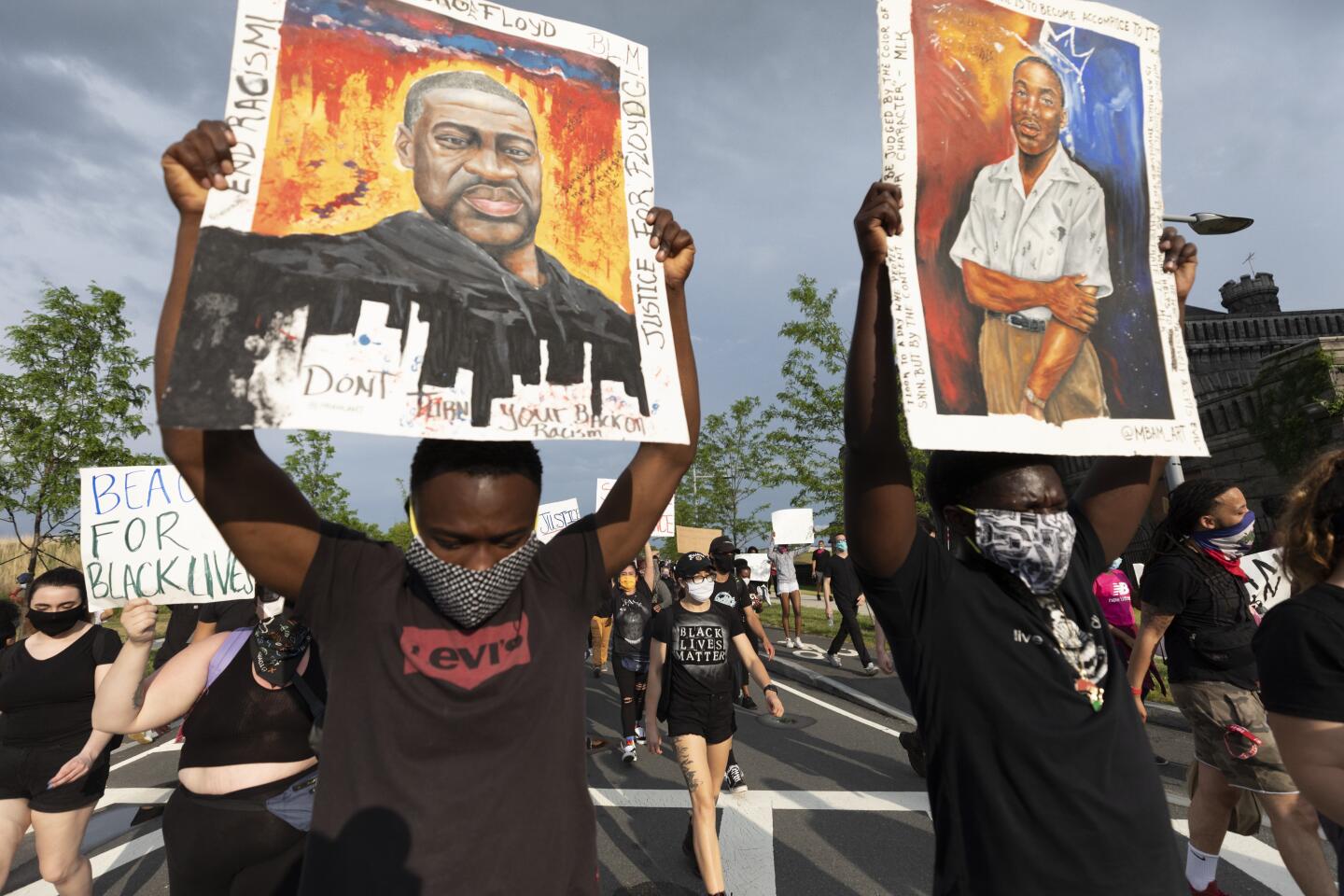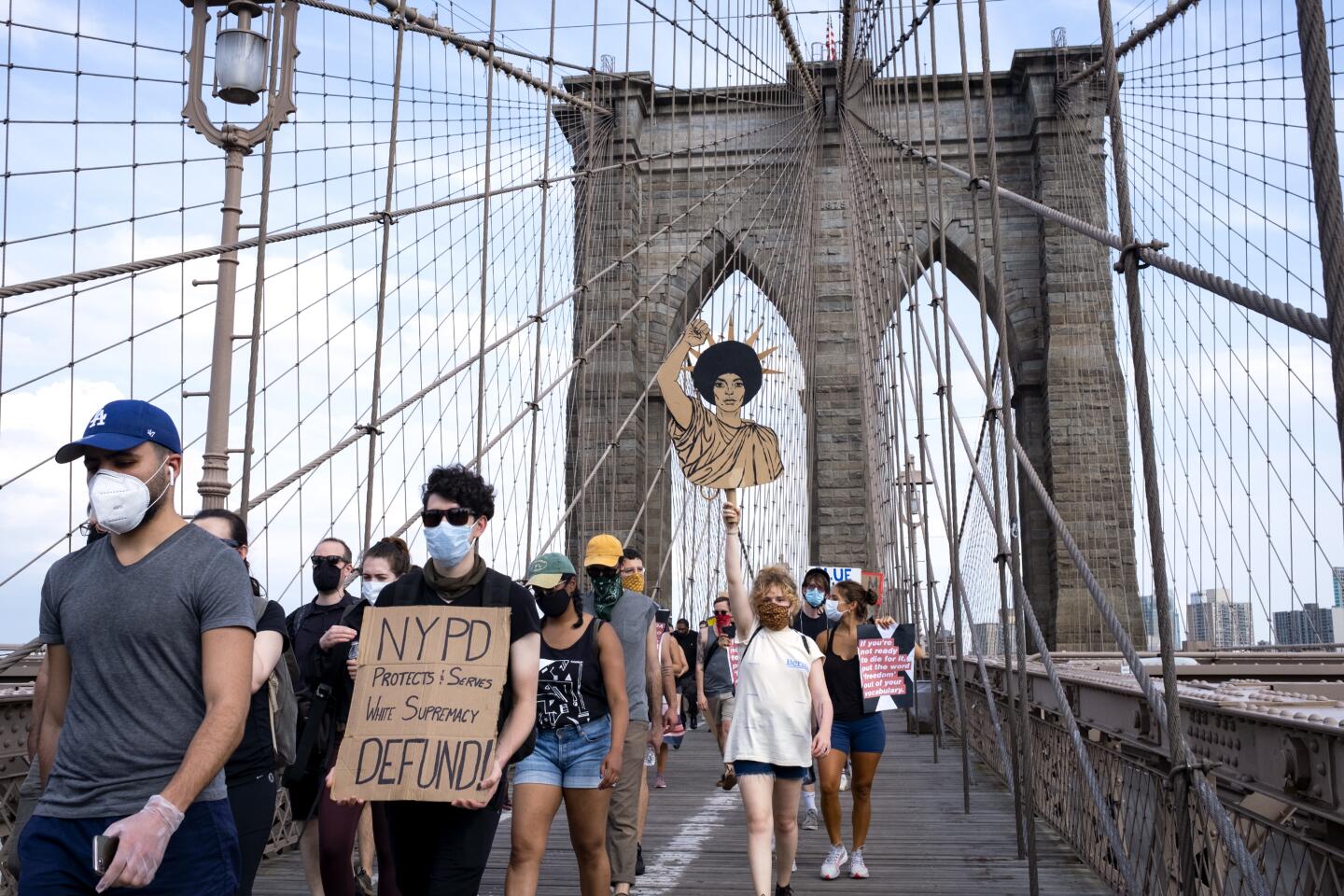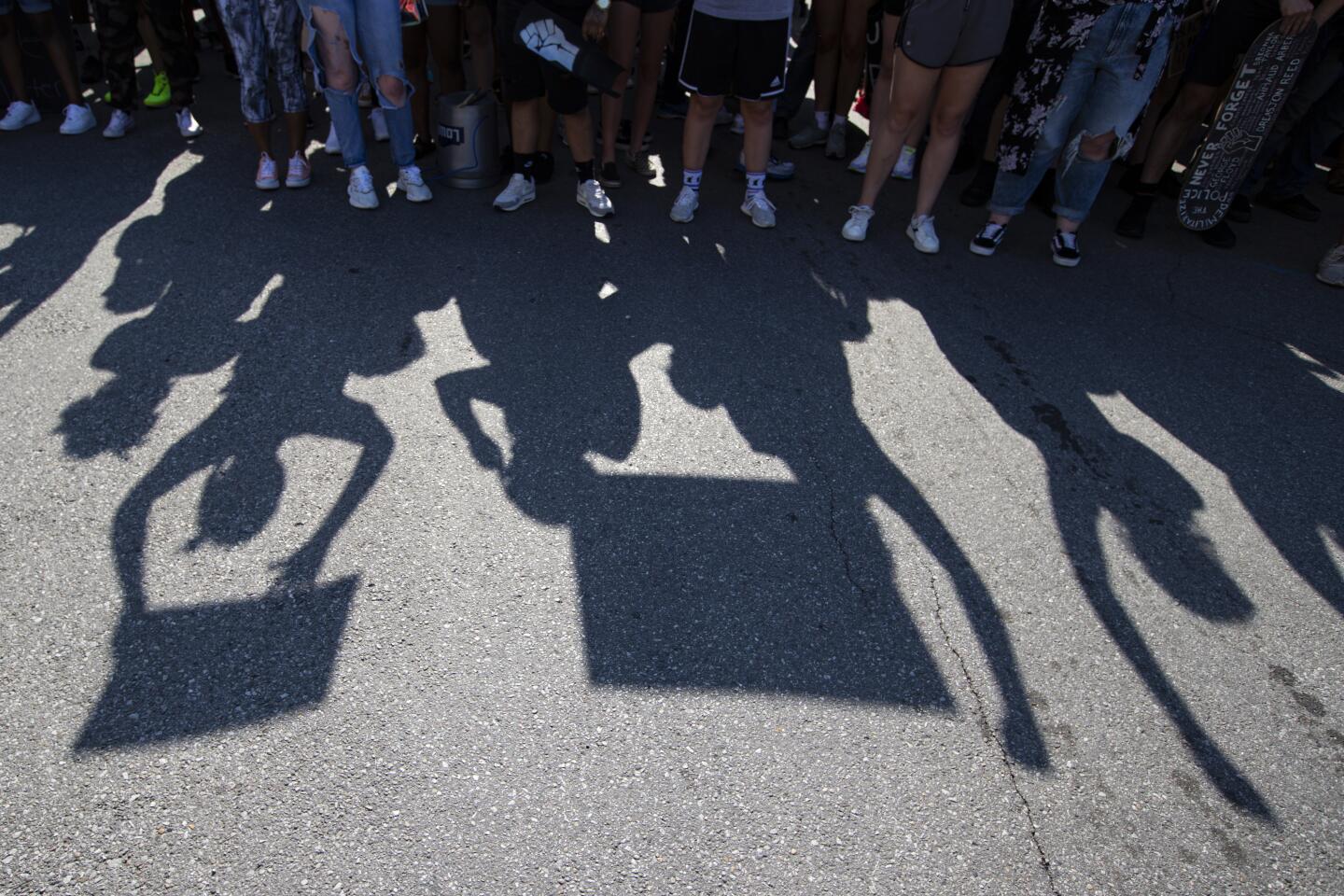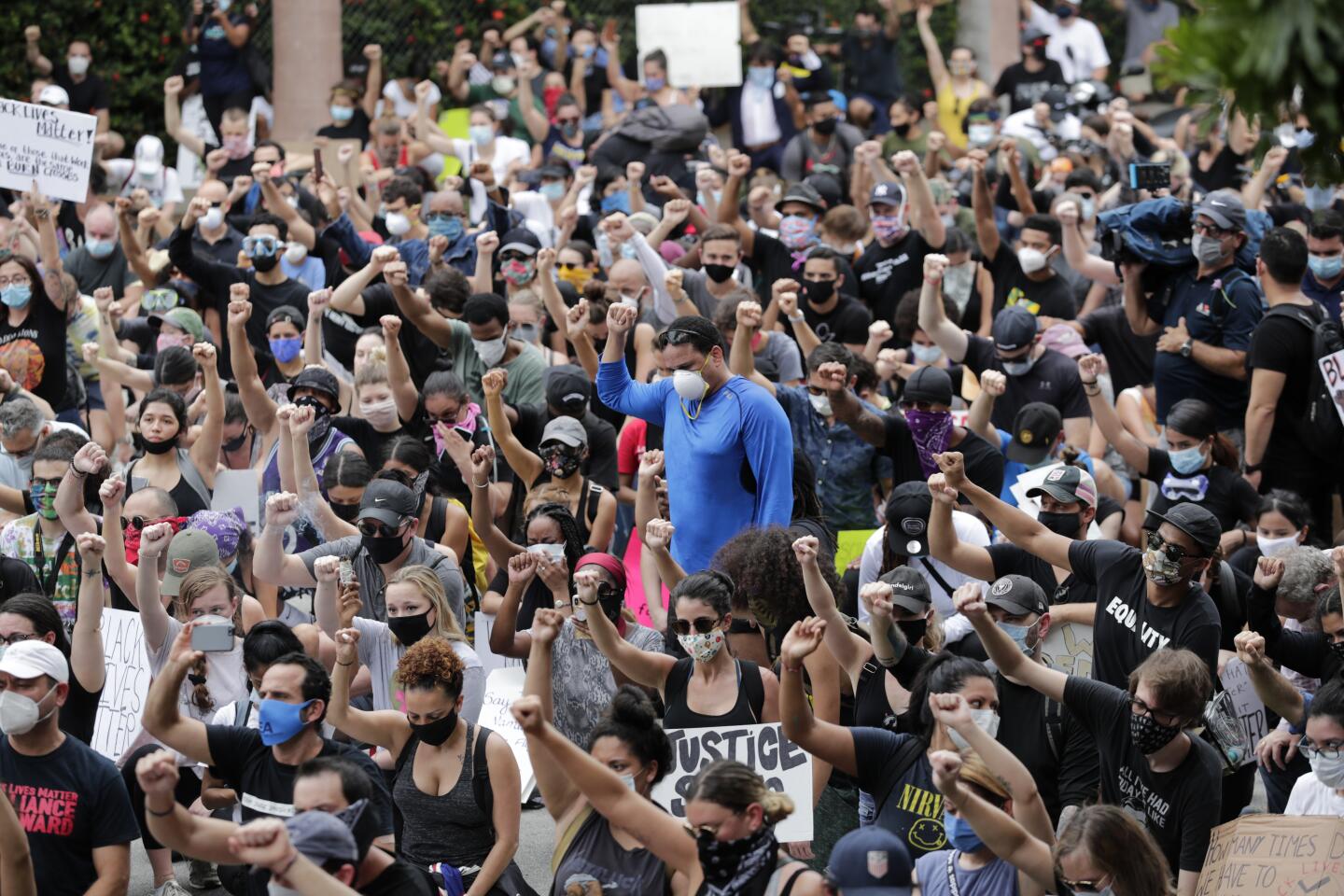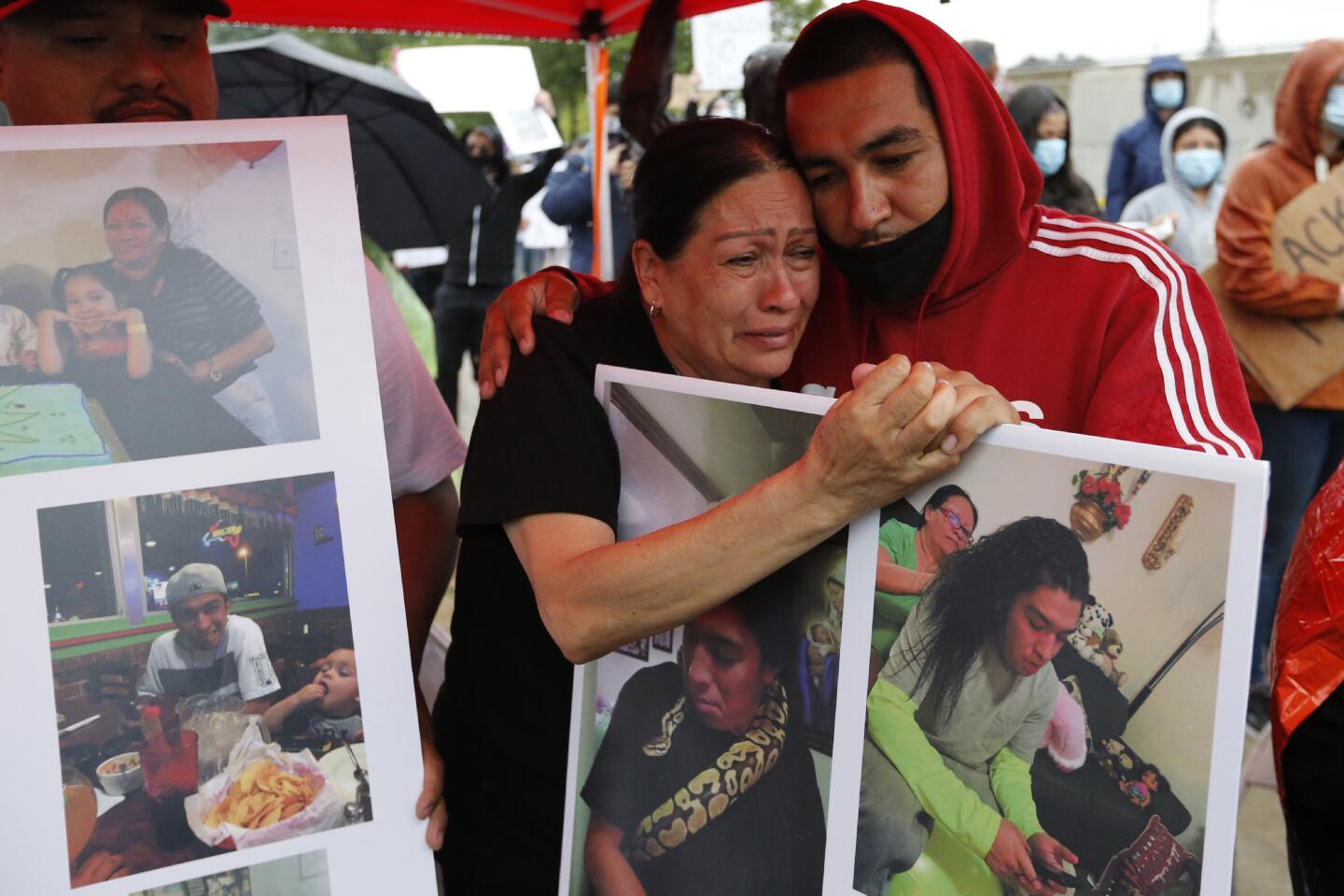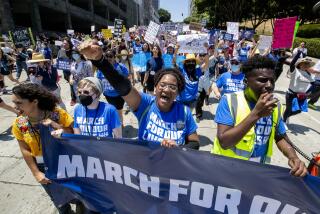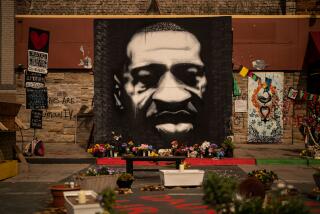Across the nation, Americans demand justice in protests loud, raucous and peaceful
- Share via
They jammed onto the Brooklyn Bridge. Flowed past the White House, newly fortified to keep the nation’s citizens at bay. Forced city officials to close Chicago’s famed Lake Shore Drive. Marched on USC, Sunset Boulevard, Beverly Hills, Los Angeles City Hall, San Pedro, Huntington Beach.
Tens of thousands of demonstrators took to the streets across the country Saturday — in some cities, for the 10th straight day — to protest the killing of George Floyd, a black man who died May 25 in Minneapolis with a white police officer’s knee on his neck.
The protesters demanded justice. They called for racism and police brutality to end. They were loud. They were boisterous. And they were peaceful.
There were no apparent incidents of vandalism or looting by Saturday evening, no broken windows or stolen goods. And for the most part, the throngs of law enforcement officers in riot gear stood down. Unlike earlier in the week, there were no reports of tear gas, rubber bullets or police batons connecting with flesh in most cities across the country.
Mayors marched. Nurses waved signs, wore masks, handed out hand sanitizer. Denver Broncos football players and staff joined protesters leaving the Colorado Capitol. Law enforcement agents in some cities took a knee — the near-universal sign of anti-racist protest, thanks to former San Francisco 49ers quarterback Colin Kaepernick.
In a perfectly California touch, a white Tesla was parked in the middle of Sunset Boulevard as its occupants handed out water and food. At Hollywood and Vine, Jose Lagunas waved a rubber facsimile of President Trump’s head on a stick. “If there’s one thing I’ve learned,” he said, “it’s that stuff like this gets good attention and spreads the message.”
Lagunas, who has marched in four demonstrations in the last week, was among thousands of people at more than a dozen Los Angeles-area protests Saturday raising their voices against the unjust killings of black Americans.
They honored Floyd; Breonna Taylor, a black emergency medical technician shot dead by police in March in her Louisville, Ky., home; and Ahmaud Arbery, a black jogger chased and shot to death by two white men in February in Georgia, among others.
Andrea Gonzalez brought her mother, husband and three children to the growing crowd at Los Angeles City Hall on Saturday afternoon. It was the first time her children — ages 4, 6 and 7 — had hit a protest line. The family drove from San Dimas to take part.
“We brought them out here because it’s important to show them why we respect all human lives,” Gonzalez said, “and that even though we are brown, we support black lives.”
Said her mother, Micaela Ruiz, who has vivid memories of the 1992 Los Angeles riots: “Silence is acceptance.”
A group of about 50 nurses and other healthcare workers from Ronald Reagan UCLA Medical Center, UCLA Santa Monica Medical Center, Keck Medicine of USC, Children’s Hospital Los Angeles and Kaiser Permanente joined the protest in front of City Hall after months of working around the clock to help COVID-19 patients.
“We left the front lines to come here. We felt a lot of anger, and as patients’ advocates, we felt we needed to speak up about the injustice,” Kannitha Lor, 25, said.
Black communities have been hit especially hard by the coronavirus — a major reason the healthcare workers joined in the demonstration, they said.
“Racism is a public health crisis,” said Delilah Garcia, 24, noting the disproportionate number of black patients she sees in comparison to other races. “Enough is enough.”
Wearing scrubs and face masks, in accordance with coronavirus restrictions, and holding signs that read “Nurses for Black Lives Matter” and “If someone says they can’t breathe, you help them,” they offered hand sanitizer to other protesters and were prepared to offer medical assistance if needed.
Hundreds of demonstrators gathered at about 2 p.m. around the Federal Building on Wilshire Boulevard in Westwood. One woman, wearing a black beret and a “Black Girls Rock” T-shirt, stood in the street blocking traffic, while another laid in the middle of a nearby intersection, face down.
Then dozens of protesters joined in, lying on their stomachs in the street. They stayed there, silent and immobile, for several minutes. Then they rose and began to chant, “Say their name” and “Breonna Taylor.”
In Washington, D.C, thousands of people converged on the newly — and officially — named Black Lives Matter Plaza in front of the White House, which now resembles a fortress, surrounded by high fences and concrete barriers.
Black Power activists came, along with women from the YWCA. Army vets and union recruiters. Heavily tattooed people and women in hijabs. Children and gray-haired grandmothers. Federal workers, priests, doctors in scrubs, people with Bibles who seemed familiar enough with the book to know how to hold it.
Unlike earlier in the week, there was minimal police presence and no reports of violence or vandalism. The mood was serious and passionate but also peaceful and friendly.
And the mayor was there.
“You know we have to speak up loudly for more justice and more peace!” Mayor Muriel Bowser called out to the crowd.
Few American cities have embraced the demonstrations over the police killing of Floyd and over the heavy-handed federal response as enthusiastically as the District of Columbia. And that has led to a battle between the mayor and the president.
At Bowser’s order, public works crews on Friday painted “Black Lives Matter” in huge neon-yellow letters, stretching from curb to curb and down two full city blocks on 16th Street, which leads directly to the White House. Trump snapped back on Twitter, calling her “incompetent.”
“The silent majority cannot be silent anymore,” said Eileen Suffian, a 64-year-old accountant who attended the Washington rally with her dog Moxie. “Where there is justice somewhere, there is justice everywhere.”
As part of the age group considered most vulnerable to the coronavirus, Suffian said she spent weeks trying to avoid crowds. But after federal officials deployed riot police, National Guard troops, chemical gas and low-flying military helicopters to scatter peaceful protesters Monday near the White House, she had to act.
“The government mobilizing the Army against its own citizens — I never thought I’d live to see that,” she said.
The protests have so far appeared successful in shifting public discourse and bringing to the forefront what many say are long-overdue conversations about police brutality and institutionalized racism in America.
In Ferguson, Mo., voters last week elected Ella Jones as the city’s first black mayor. This is the same town where 18-year-old Michael Brown was shot dead by a white police officer six years ago.
In Virginia, civil rights activists are celebrating Gov. Ralph Northam’s decision to remove a statue of Robert E. Lee from Richmond. Meanwhile, in Louisville, Mayor Greg Fischer announced last week that the police department’s use of no-knock warrants is suspended indefinitely.
On Saturday, the question loomed: How long will the protests continue? So far, there seems to be no answer, just protest signs, impassioned chants and more marching.
In Atlanta, thousands of protesters, black and white, marched downtown in humid 85-degree heat, shouting, “No justice, no peace.”
Just before dusk, Amisha Harding, 41, a nonprofit consultant and realtor, wiggled her hips beside a loudspeaker in Centennial Olympic Park, belting out Bob Marley songs and encouraging marchers to write on a “healing board.”
For days, she had come downtown because she worried about her 18-year-old son, a student at Morehouse College.
“I still fear for his life,” she said. “As a mother, I couldn’t imagine not being here. We have to get to the point that everyone recognizes racism is a problem.”
On her first day protesting, the mood was tense as demonstrators yelled at one another and police deployed tear gas. The people, she feared, could not sustain so much dark emotion. So on Monday, she and her cousin brought a speaker to blast disco and hip-hop.
They wanted to create a more positive vibe. Protesters danced, and the mood lightened. By Thursday, a few members of the National Guard were tapping their feet. She coaxed them onto the impromptu dance floor.
One or two broke formation. Then the major joined in, then the general.
Before long, more than a dozen men and women dressed in camouflage were doing the electric slide, their batons and assault rifles swinging to the beat. The next day, she got them to do “Macarena.”
“It was so beautiful,” Harding said Saturday. “Protesters saw the humanity in them, and they saw the humanity in the protesters. We created a place for unity.”
By Saturday, the city had lifted its 8 p.m. curfew. At dusk, no police in riot gear were within sight of Centennial Olympic Park or blocking the CNN Center, where windows had been smashed eight days earlier.
Times staff writers Jenny Jarvie, Amy Kaufman, Ruben Vives, Sonali Kohli, Arit John, Colleen Shalby and Alex Wigglesworth contributed to this report.
More to Read
Sign up for Essential California
The most important California stories and recommendations in your inbox every morning.
You may occasionally receive promotional content from the Los Angeles Times.
